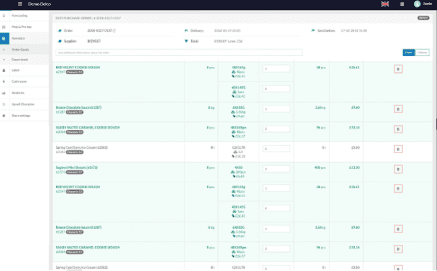According to estimates, the restaurant industry generates close to one million tonnes of food waste each year. This accounts for roughly 12% of all food thrown away in the UK – pretty staggering figures all things considered.
The ethical, moral and environmental implications are fairly obvious here. But in cold business terms, this level of restaurant food wastage costs the sector more than £3 billion annually. Understandably, these figures frequently give rise to the tricky question of how to reduce food waste in restaurants. Before exploring the solutions, it’s worth looking at the causes.
What Are the Reasons for Food Waste in Restaurants?
According to campaigners, 45% of restaurant food waste is the result of dish preparation, 34% comes from food left over by diners and 21% is caused by spoilage. Behind these numbers is a rogue’s gallery of operational inefficiencies and improper practices that remain prevalent across the F&B sector. Some of the most common reasons for food waste in restaurants are:
- Inefficient Inventory Management
- Inaccurate Portion Control
- Poor Menu Planning
- Overloaded Menus
- Inadequate Shelf-Life Monitoring
- Inaccurate Demand Forecasting
- Inefficient Stock Rotation
- Poor Supplier Management
- Lack of Meaningful Data
- Lack of Customer Feedback Systems
- Improper Storage Methods
- Lack of Ingredient Repurposing Plan
- Poor Quality Control
- Inadequate Stock Taking Procedures
- Overuse of Ingredients
- Reliance on Outmoded/Legacy Systems
How to Reduce Food Waste in Restaurants – 20 Actionable Tips
To reduce the exorbitant costs associated with wastage, here are 20 proven food waste management strategies that will have a big impact on your bottom line.
1. Avoid Overstocking
One of the number one causes of restaurant food wastage is over purchasing. Typically the result of gut-feeling decisions and inefficient inventory management, this wasteful practice can prove extremely costly for your restaurant.
To avoid it, a comprehensive inventory management system needs to be in place that provides key data about what’s in and what needs to be ordered. This means actionable data about every single ingredient.
It’s also important to have access to historical sales data, preferable via a centralised system. From this, accurate demand forecasts can be generated to help ensure stock levels remain optimised during the inevitable fluctuations in demand. This will enable you to only purchase what you expect to sell.
To prevent overstocking, a lot of restaurants employ the just-in-time system. By ordering ingredients as close as possible to when they’re likely to be used, you’re effectively aligning supply with demand. Thus, the potential for spoilage is reduced.
Conducting regular inventory checks is important too, enabling you to gain an understanding of what ingredients are to hand. You’ll be able to get a handle on slow-moving items and adjust future purchases accordingly.
Don’t forget to work with suppliers either. Overstocking can be further reduced if you can arrange for smaller, more frequent orders.
2. Closely Monitor Expiry Dates
To avoid spoilage, setting up a shelf life tracking system is absolutely essential. Categorising inventory items according to perishability (dairy, dry goods, fresh produce etc) is a good place to start. This makes it easier to monitor items with shorter shelf lives.
In categorising your ingredients, it’s good practice to allocate specific areas of your storage facility for those items that are close to expiry. They should be easily accessible to staff and clearly labelled.
A cohesive stock-rotation system should also be in place. The first in first out method is perhaps the most popular among F&B operators. Using inventory items that have been in storage the longest will ensure that they don’t go to waste. But it’s a method that has to be applied consistently and accurately.
.jpg?width=636&height=424&name=blog_content2(1).jpg)
3. Implement an Efficient Inventory Management System
Efficient inventory management should be absolutely central to any restaurant waste management plan. And as you can probably see, it’s interconnected with many of the tips that we set out in this article.
An effective restaurant stock management system, will be well organised and transparent, allowing you to monitor and track the movement of ingredients, products and supplies with ease.
Ideally, you’ll want a system that provides clear data about your stock levels so that you can see what you’ve got in and what needs to be reordered. Mechanisms to track and analyse waste can also prove extremely helpful as we shall see.
With an accurate tracking framework in place as well as actionable data, it becomes much easier to make informed purchases and ensure optimum stock levels.
4. Simplify Your Menu
A large menu requires a wide variety of ingredients, many of which are going to be used infrequently. This often leads to spoilage.
The obvious solution here is to create a streamlined menu requiring less ingredients. In this regard, cross utilisation can prove especially useful – utilising things like sauces or condiments for multiple dishes can actually streamline your inventory, free up storage space and ultimately cut down on wastage.
A less complicated menu also means a less complicated inventory. With fewer items to monitor and track, it becomes easier to manage stock levels, thus reducing the chances of overordering. In the kitchen, your staff will be unburdened by the complexities of preparing a wide variety of dishes.
This reduces the likelihood of mistakes and over portioning, while ensuring that only the appropriate ingredients are used for each dish.
5. Analyse Your Menu
To minimise waste, your menu needs to be well-curated. On one hand, you’ll want to emphasise the most popular dishes on your menu to drive profitability. But on the other, you’ll need to identify poorly performers so that they can be removed to avoid wastage.
This requires careful menu management. You should therefore have in place a method that enables you to review all sales data. Provided the data is accurate, it becomes easier to create reliable forecasts that help to align your menu with demand. By understanding what dishes your customers are more likely to order at any given time, you can avoid preparing food that doesn’t sell.
In a broader context, menu analysis will help you to streamline your restaurant’s offerings by focusing on high-margin, high-demand dishes. With such a focus, you’ll be able to simplify your inventory, prevent over-ordering and ensure that all of your ingredients are used efficiently.
6. Ensure Strict Portion and Ingredient Control
If you’re setting up a restaurant food waste management plan, this is going to be a critical step. Ensuring strict portion and ingredient control will dramatically reduce the waste commonly associated with food prep.
To do this, you need to provide staff with clear prep guidelines relating to each dish. This means a standardised, centrally accessible document setting out clear information about portion sizes, as well as the type and amount of ingredients to be used.
With this information to hand, your kitchen staff will be able to prepare dishes more efficiently while also ensuring consistency.
.jpg?width=636&height=424&name=blog_content3(1).jpg)
7. Repurpose Leftovers
Sadly, a lot of F&B operators assume that food waste is unavoidable. To an extent this is certainly true. But the creative repurposing of close-to-expiry stock is a sustainable practice that should be included as part of any plan to reduce restaurant food wastage. Of course, this is only possible if items are properly categorised according to their shelf life and clearly labelled.
With a repurposing system in place, you’ll be able to develop a sound plan. For instance, vegetable trimmings could be used to make soups and stocks, older bread could be used as croutons or bread pudding and surplus cooked meats repurposed into sandwiches. .
9. Accurately Record All Restaurant Food Waste
It’s not possible to manage restaurant food waste without knowing how much it generates. A common approach is to manually track waste either on paper or more commonly, via a spreadsheet. If you choose to use this method, it’s important to categorise waste according to the actual sources, be it preparation waste, plate waste or spoilage. Clear reduction goals should also be set.
In creating a waste log, be sure to regularly evaluate your data to identify trends and patterns from which you can adjust portion sizes. But keep in mind that relying on a manual waste logging can be extremely complicated. This is why many operators rely on tech solutions to keep track of their restaurant food wastage – more on this later.
9. Set Up A Food Composting Scheme
While food composting doesn’t prevent food waste, it’s a process that provides a sustainable way of managing the kind of restaurant food waste that just can’t be avoided. Composting can reduce the impact of landfills and encourage waste-awareness among staff. It also means that your restaurant is contributing to a circular economy in which food waste is turned into nutrient-rich composts.
As with donating food to banks and shelters, the impact on your business may not be immediately tangible. But the positive effects on brand reputation may have the effect of driving more customers your way. If you decide to set such as scheme up, be sure to tell people about it!
10. Include Portion Size Information on Your Menu
34% of restaurant food waste comes from food left over by diners. An effective way to tackle this problem is to clearly indicate the portion sizes of every single dish on your menu. Including calorie information can also be helpful.
As a result of this practice, your customers will have a better idea of what to expect from each item. This reduces the likelihood of them ordering more food than they can consume. The impact on plate waste could be significant.
.jpg?width=636&height=424&name=blog_content4(1).jpg)
11. Donate Food to Food Banks and Shelters
Donating food to food banks and shelters is an ethical way to prevent food wastage in restaurants. But has other direct benefits. For one thing, cutting down on the amount of food you throw away reduces disposal costs.
It also makes for a leaner inventory which in turn frees up storage space. And in the longer-term, donating to food banks and shelters will improve your brand’s reputation potentially leading to more customers.
12. Ensure Accurate, Regular Stock Takes
Stock taking is another key area that needs to be addressed when planning food waste management in a restaurant. Accuracy and regularity are critical here.
To reduce food waste arising from poor stock-taking practices, you need to ensure regular and systematic checks. These should be scheduled on a weekly or bi-weekly basis. Staff should also be trained thoroughly on how to make accurate counts, record data and identify potential contamination or spoilage issues.
With accurate stock taking procedures in place, you’ll know precisely what you’ve got in which will help to drive more accurate purchasing.
13. Encourage Customer Feedback
Putting in place a customer feedback system can play a crucial role in reducing waste in restaurants. From it, you can glean invaluable insights about things like portion sizes and menu preferences.
Feedback on portion sizes allows you to make the requisite adjustments to dishes, thus reducing plate waste. And with a full understanding of your most popular dishes, you’ll be able to focus on popular dishes and strike off poor performers, thereby minimising the purchase of associated ingredients that would go to waste.
14. Educate Customers on Waste
This one might need a more delicate approach. But educating and engaging customers on food waste might be an approach worth considering. Including information on your menu about where ingredients are sourced, as well as your restaurant’s commitment to sustainability, may cause customers to become more mindful when ordering. And if you create dishes using surplus ingredients let your customers know. It may have a similar effect.
.jpg?width=636&height=424&name=blog_content5(1).jpg)
17. Educate Your Staff
The question of how to reduce food waste in restaurants should also be directed at your staff. Indeed, educating employees about the importance of waste reduction can be a powerful cost-saving strategy.
So consistently emphasising the importance of waste reduction and training your staff on ingredient usage, dish portioning and food handling. The key here is to foster a culture of sustainability within your restaurant. Staff that understand the environmental and financial impact of wastage are more likely to take proactive steps to avoid it.
15. Ensure Proper Storage Practices
Good restaurant food waste management depends on sound storage practices. To begin with, temperature control needs to be monitored carefully to prevent the growth of bacteria, while ensuring that food remains fresh for longer. As already touched on, the labelling needs to be clear as well with decipherable information about expiry dates.
Storage areas need to be well organised too so that your staff can easily locate and access all ingredients. Items hidden by teetering towers of boxes stacked floor to ceiling, will probably go unnoticed and spoil.
16. Carefully Manage Your Suppliers
Manage your supplier relationships carefully. Clearly define your expectations and quality standards to them with detailed specifications about freshness and packaging. Regular quality checks should also be conducted. Otherwise, you leave yourself open to substandard and/or close-to-expiry ingredients.
Establishing strict delivery schedules that closely align with your restaurant’s turnover is crucial, By ensuring timely delivery, you'll avoid the overstocking that often results from early deliveries. Rushed food prep arising from the late arrival of ingredients can also be eliminated.
18. Offer Discounts on Near-Expiry Items
Running special discounts and deals on close-to-expiry items that might otherwise go to waste is another effective strategy. As well as ensuring that perishable ingredients are used before they spoil, you’ll be recovering at least some of the cost that would have been lost if the items were disposed of.
Keep in mind that in the current economic client, many customers are looking for value deals. So providing patrons with the opportunity to save money has the potential to drive sales and build loyalty.
19. Provide Takeaway Options
Offering your customers the proverbial ‘doggy bag’ is another strategy to be included in your plan to reduce waste in your restaurant. As mentioned, plate waste is one of the biggest contributors to wastage. Providing your customers with the option to take away their unfinished food therefore makes sense.
Obviously, you’ll need to inform and potentially remind your servers - it can be easy to forget during busier periods. Although not very common in UK restaurants, you could also include information about your take away service in the menu as a means of encouraging more mindful ordering among your patrons.
.jpg?width=636&height=424&name=blog_content6(1).jpg)
20. Implement the Latest Tech
The use of tech is the 20th actional tip in our guide on how to reduce restaurant food waste. And it’s a powerful, potentially transformative approach that’s revolutionising the food and beverage sector. Many of the latest restaurant management systems allow owners to implement all of the waste-reduction strategies mentioned here.
In fact, the more advanced cloud-based platforms incorporate all operations areas of a restaurant, providing an end-to-end system that streamlines and monitors key processes. From sales and restaurant forecasting, to real-time inventory management and automated purchasing, these powerful systems have the potential to drastically reduce food waste.
With this in mind, we encourage you to browse our site to learn how Syrve can streamline your business in all of the areas that help to cut down of wastage.




